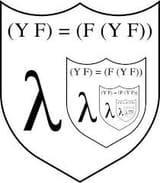Anonymous
6/17/2025, 1:15:54 AM No.16699607
Sorry if this belongs on /g/. According to the YouTube vid, https://youtu.be/RcVA8Nj6HEo?si=Km1_ngxCfakjZ7nX
Around 19 minutes in, the YouTuber starts talking about fixed points of lambda terms and real valued functions. The fixed point of x^2+2 only has fixed points in the complex numbers. My question is, will applying the fixed point combinator to the lambda term for x^2+2 result in a lambda term that "acts like" a complex number?
Around 19 minutes in, the YouTuber starts talking about fixed points of lambda terms and real valued functions. The fixed point of x^2+2 only has fixed points in the complex numbers. My question is, will applying the fixed point combinator to the lambda term for x^2+2 result in a lambda term that "acts like" a complex number?
Replies:
